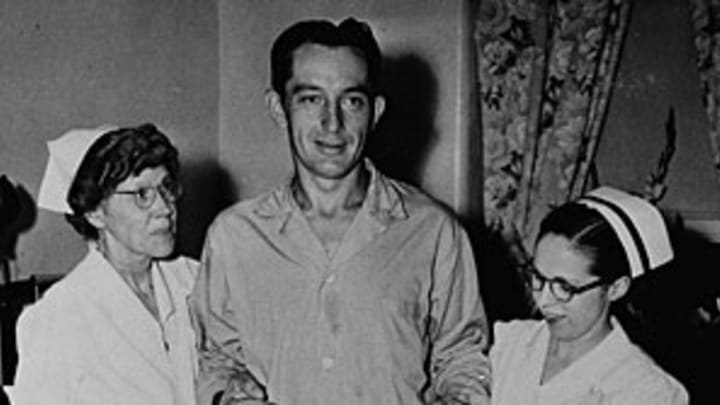Waitkus remembered for being shot, but he was no Natural

Eddie Waitkus was never the same after he was shot by Ruth Ann Steinhagen and landed in the hospital. (AP)

By Cliff Corcoran
Ruth Ann Steinhagen, the obsessed Cubs fan who shot Phillies first baseman Eddie Waitkus, a former Cub, in a Chicago hotel on June 14, 1949, inspiring the pivotal event of Bernard Malamud's The Natural, died of natural causes on Dec. 29, a fact that just hit the news wire this weekend. The news of her death is likely the first time many fans of the Barry Levinson film based on Malamud's novel have heard of her or Waitkus, but to say that Waitkus was the inspiration for the iconic Roy Hobbs, the character played by Robert Redford in the film is a bit of a stretch.
In The Natural, Hobbs was shot as a teenage phenom before ever reaching the major leagues and the shooting kept him from reaching the major leagues until the age of 34, at which point he immediately started hitting like Ted Williams, complete with literal light-tower power. Waitkus, by comparison, was 29 and a veteran of both World War II and 448 major league games when the bullet from Steinhagen's rifle lodged near his heart. Waitkus nearly lost his life as a result of the incident and the surgery required to remove the bullet, but he was back in the Phillies' Opening Day lineup the next year, going 3-for-5 as their first baseman.
That spectacular comeback aside, Waitkus, who died in 1972, was no Hobbs at the bat. Though he was enjoying his finest season when he was shot, he had just one home run in 246 plate appearances, and when he retired in 1955 at age 35, he had just 24 home runs in 4,681 career PAs. Waitkus hit for respectable averages (.304 in 1946, .306 in 1949 before the shooting, .285 on his career), but they were empty. He hit for little power and drew only an average number of walks. He did make a pair of All-Star teams and drew some low-ballot MVP votes in two seasons, but only thrice did he surpass two wins above replacement, the approximate value of an average non-star regular (per Baseball-Reference's WAR), peaking at 2.7 in 1948, when he hit a career-high seven home runs.
